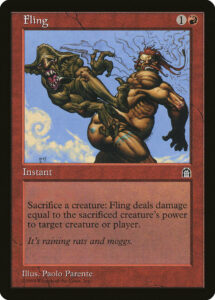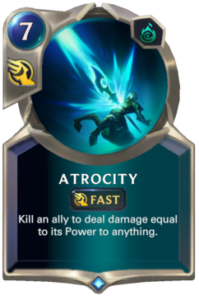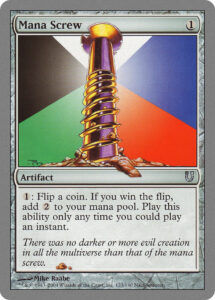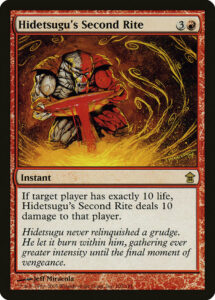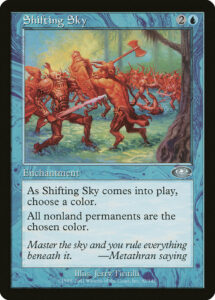Every effect on every card in Magic is historically significant. There is precedent for them all, even the most unprecedented mechanics. And every card, even the most mundane-seeming, create new precedent for new designs to build upon. Today, however, we’ll go beyond the very bounds of Magic to discuss one of Magic’s older effects: the humble and silly Fling.
Have you met my friend, Chuck?
Fling is a simple effect that tells a lovely little story. The effect is obvious: you throw your creature at something, so of course it hurts as though it were hitting it in combat. And because you throw your creature, it goes splat.
Technically, Fling didn’t pioneer this effect—Sword of the Ages did in Legends, followed by Freyalise Supplicant in Ice Age, Flame Elemental in Mirage, and Final Strike in the original Portal. But Fling was and remains the cleanest and clearest execution of this effect. And since its initial printing in 1998, Fling has been printed an additional 15 times, while Magic has only added 16 new Flinging cards. That’s a testament to how well designed and balanced the card is. It’s never very powerful, but it feels good to cast in response to an opponent’s removal spell. And every now and then, it’s used as part of a combo finish to kill with an arbitrarily large creature without needing to attack.
Fling effects don’t only exist in Magic, however. Change a few things in its context and Fling goes from a weak but fun playable (that’s occasionally a combo finisher) into a format-defining card that demands a nerf. But to discuss that, we’ll have to talk about Legends of Runeterra’s recently-nerfed version of Fling. And if you’ve never played LoR before—don’t worry, you don’t need to know how to play to compare the two cards. I’ll gloss over a few things and speak in Magic-ese the whole time.
With that said, let’s talk about Atrocity.
Fling, but worse in every way
If Atrocity were a Magic card, it wouldn’t just be Fling, it would be a much, much weaker version of Fling. Atrocity is a seven-mana spell. Fling obviously costs two. Your opponent can only stop a Fling with a Counterspell effect, but in LoR, your opponent can use Doom Blade, Counterspell, Unsummon, and Diminish effects to downgrade your Atrocity into jaywalking. And yet despite Legends of Runeterra bearing many similarities, Fling is a bit player, while Atrocity was just nerfed from costing six to seven. That’s a crazy chasm caused by context.
Restrictions breed utility
All card games are defined by their restrictions, but not all card games feature the same restrictions. Games of Magic are perhaps most restricted by card flow and the mana system. You only draw one card a turn cycle, yet you need to draw a balance of lands and spells. You need to draw the right colors of mana, you want to draw cheap spells early and expensive spells late, and you eventually reach a point where additional lands are useless. Cards being the center of tension is why card advantage has been key to victory for so much of Magic’s history. It’s also why built-in two-for-ones like Bonecrusher Giant, incredibly powerful cards like Emergent Ultimatum, and strong mana ramp like Wilderness Reclamation and Growth Spiral have shifted Magic’s balance a bit away from card advantage.
Legends of Runeterra has almost none of these restrictions. As with Hearthstone, you don’t put lands into your deck—you always get one more mana each turn and there is no color screw. But LoR goes even farther, letting you carry over some unused mana across turns, making mana even less of a constraint. Without lands in your deck, you always draw action, and because of LoR’s turn structure, you draw a card every turn, not just on your turn. So mana and cards are far less of constraints than they are in Magic.
The Rite way to win
Legends of Runeterra has its own restrictions to compensate for eschewing Magic’s biggest. While Magic allows you to have an incredibly large number of creatures on the battlefield at once (though Arena did need to create a clear limit thanks Scute Swarm), LoR allows each player a maximum of six creatures at a time. Magic allows you to gain an arbitrarily large amount of life, but your highest possible life total in LoR is your starting total of 20. Add in the fact that creatures in LoR are generally stronger for their cost than they would be in Magic and all creatures have haste and you may start to see its different pain points.
It’s a lot easier and faster to do 20 damage in LoR than it is in Magic. Accordingly, maintaining tempo and managing your life total are major pain points. Lifegain in Magic is generally bad (unless it’s incidental on an already-playable card or a dedicated anti-burn card), whereas it’s common in many LoR decks. It’s really, really hard to kill someone with a Fling in Magic, even if they’re at half-life, because there just aren’t that manynten-power creatures. There just aren’t many cards like Embercleave or Torbran, Then of Red Fell than do that much damage out of nowhere (and both require a prior board presence). But in LoR, you can pretty easily have a ten-power Nasus with Hexproof (well, LoR’s version of Hexproof) hit your full-health opponent and then immediately Atrocity them to death. That’s why Atrocity got nerfed, even though it’s substantially weaker than Fling in a game with generally more powerful cards.
Hopefully you’ve enjoyed dipping into another game to appreciate our game a little more. While there’s a lot to learn within Magic and comparing effects to their historical forebears, there’s also much to learn by comparing Magic with its contemporaries. Every game tweaks the boundaries a bit; seeing these boundaries can be key to winning tournaments, building decks, or just appreciating the design of the components. Atrocity and Fling are an especially stark example given Atrocity’s recent nerf, but there are plenty of parallels between Magic and other games and plenty more to learn from them.
And, as always, thanks for reading.
Zachary Barash is a New York City-based game designer and the commissioner of Team Draft League. He designs for Kingdom Death: Monster, has a Game Design MFA from the NYU Game Center, and does freelance game design. When the stars align, he streams Magic (but the stars align way less often than he’d like).

